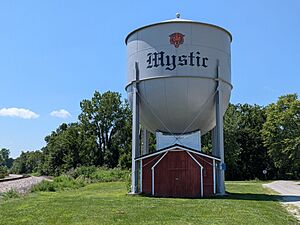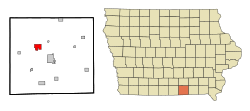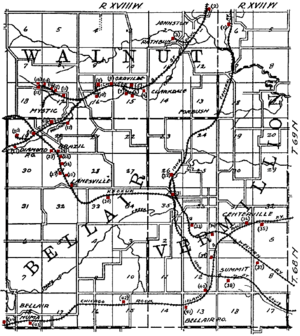Mystic, Iowa facts for kids
Quick facts for kids
Mystic, Iowa
|
|
|---|---|
|
City
|
|

A railroad water tank near the south end of Mystic
|
|

Location of Mystic, Iowa
|
|
| Country | USA |
| State | |
| County | Appanoose |
| Area | |
| • Total | 2.94 sq mi (7.63 km2) |
| • Land | 2.94 sq mi (7.63 km2) |
| • Water | 0.00 sq mi (0.00 km2) |
| Elevation | 955 ft (291 m) |
| Population
(2020)
|
|
| • Total | 322 |
| • Density | 109.38/sq mi (42.22/km2) |
| Time zone | UTC-6 (Central (CST)) |
| • Summer (DST) | UTC-5 (CDT) |
| ZIP Code |
52574
|
| Area code(s) | 641 |
| FIPS code | 19-55200 |
| GNIS feature ID | 2395146 |
Mystic is a small city located in Appanoose County, Iowa, United States. In 2020, the city had a population of 322 people. It is known for its history as a coal mining town.
Contents
History of Mystic
Mystic got its name from Mystic, Connecticut. In the late 1800s, the area around Walnut Creek was full of mining camps. These camps had different names like Jerome, Diamond, Mystic, and Clarkdale.
The first coal mine in the Mystic area opened in 1857. It was started by A. M. Elgin. The coal was easy to find because it was close to the surface. Over the years, many small mines were dug and then closed, making the hills look like a honeycomb.
In 1858, Isaac Fuller opened a larger mine. This mine shipped coal to nearby Centerville for homes to use. A big change happened in 1887 when the Chicago, Milwaukee and St. Paul Railway built a train line through Mystic. This made coal mining grow very quickly.
By 1893, there were 14 mines in Mystic. There were also two mines in Brazil, a town just south of Mystic. The name "Brazil" might come from an old English word for pyrite, which is a mineral sometimes found in coal.
Miners and Unions
Miners in Mystic and Brazil joined groups to protect their rights. One of the first groups was Local Assembly 3335 of the Knights of Labor. It had 75 members in 1884.
Later, the miners joined the United Mine Workers (UMWA) in 1898. By 1902, the UMWA had many members in the area. Local 634 in Mystic had 569 members. By 1912, the UMWA had over 1,200 members in Mystic and Brazil. This was about a quarter of the total population!
In 1914, the Lodwick Brothers Coal Company in Mystic was a very successful company. It produced over 100,000 tons of coal that year. This made it one of the top 24 coal producers in Iowa.
Geography
Mystic is located in the valley of Walnut Creek. This creek flows into the Chariton River about four miles northeast of the city.
The United States Census Bureau says that Mystic covers about 2.92 square miles (7.6 square kilometers). All of this area is land.
Population Changes Over Time
| Historical population | |||
|---|---|---|---|
| Census | Pop. | %± | |
| 1890 | 875 | — | |
| 1900 | 1,758 | 100.9% | |
| 1910 | 2,663 | 51.5% | |
| 1920 | 2,796 | 5.0% | |
| 1930 | 1,953 | −30.2% | |
| 1940 | 1,822 | −6.7% | |
| 1950 | 1,233 | −32.3% | |
| 1960 | 761 | −38.3% | |
| 1970 | 696 | −8.5% | |
| 1980 | 665 | −4.5% | |
| 1990 | 545 | −18.0% | |
| 2000 | 588 | 7.9% | |
| 2010 | 425 | −27.7% | |
| 2020 | 322 | −24.2% | |
| U.S. Decennial Census | |||
The population of Mystic has changed a lot over the years. It grew quickly during the coal mining boom. In 1920, it reached its highest population with 2,796 people. After that, the population slowly decreased as mining became less common.
Recent Population Data
According to the 2020 census, 322 people lived in Mystic. There were 149 households in the city. Most residents were White. About 21.7% of the people were under 20 years old. The median age was 46.8 years. This means half the people were older than 46.8 and half were younger.
In the 2010 census, Mystic had 425 people. The population density was about 145.5 people per square mile. Most people were White. About 23.8% of the residents were under 18 years old. The median age was 39.9 years.
Education
Students in Mystic attend public schools operated by the Centerville Community School District.
See also
 In Spanish: Mystic (Iowa) para niños
In Spanish: Mystic (Iowa) para niños


